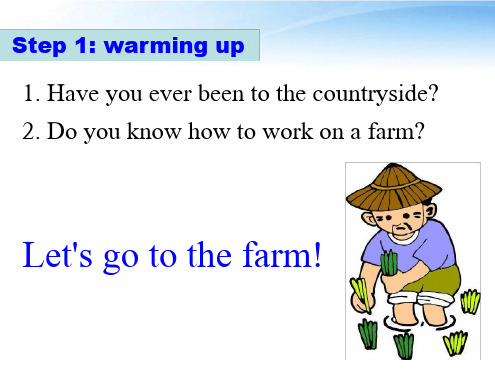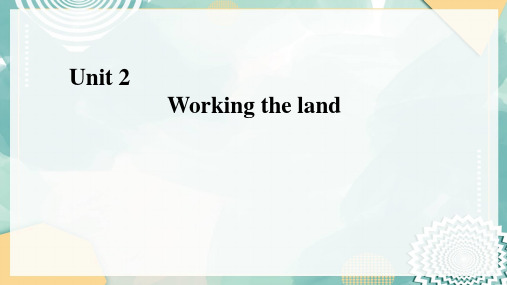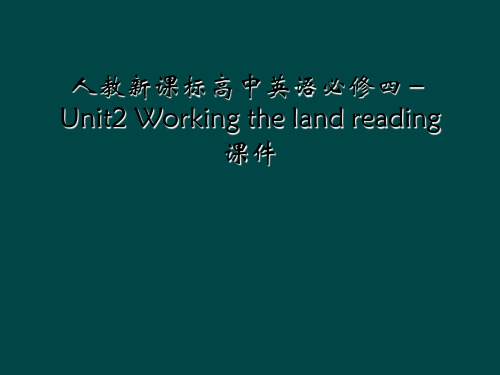新人教版 高中英语 必修4 Unit 2Working the land-Learning about Language同步学案
- 格式:doc
- 大小:125.00 KB
- 文档页数:7

人教版高中英语必修4《Unit 2 Work ing the land》教案2篇Teaching plan of unit 2 working the land编订:JinTai College人教版高中英语必修4《Unit 2 Working the land》教案2篇前言:英语作为在许多国际组织或者会议上都是必需语言,几乎所有学校选择英语作为其主要或唯一的外语必修课。
英语教学涉及多种专业理论知识,包括语言学、第二语言习得、词汇学、句法学、文体学、语料库理论、认知心理学等内容。
本教案根据英语课程标准的要求和教学对象的特点,将教学诸要素有序安排,确定合适的教学方案的设想和计划、并以启迪发展学生智力为根本目的。
便于学习和使用,本文档下载后内容可按需编辑修改及打印。
本文简要目录如下:【下载该文档后使用Word打开,按住键盘Ctrl键且鼠标单击目录内容即可跳转到对应篇章】1、篇章1:人教版高中英语必修4《Unit 2 Working the land》教案2、篇章2:人教版高中英语必修4《Unit 2 Working the land》教案篇章1:人教版高中英语必修4《Unit 2 Working the land》教案教学准备教学目标(1)知识目标:让学生通过阅读课文更多地了解我国著名的农业科学家袁隆平的科研成果及其影响。
(2)能力目标:让学生进一步使用恰当地阅读方式与技能,如略读(skimming),快速阅读(fast reading),细读(close reading)等(3)情感目标:让学生不但学习袁隆平的科研精神,更要学习他不计较名利,踏踏实实的生活态度。
教学重难点1.阅读课文更多地了解我国著名的农业科学家袁隆平的科研成果及其影响。
教学过程1.话题的引导。
(Pre-reading)1).开头通过设计了一首熟悉的诗歌,让学生知道话题---farming.2).涉及到提高产量从而解决世界饥荒问题,从而引出本节课的中心话题--伟大人物袁隆平。



高中英语必修四《unit2WorkingTheLand》全英文说课稿《unit2 Working The Land 》示范说课稿Unit 2 Working The Land (NSEFC B4)Reading: A Pioneer For All PeopleA teaching plan interpretationTarget students: students of average level in Senior 2Period under interpretation: The second period of Unit 2 Working the LandTime: 2nd, Dec, 2008Teaching material: Reading passage A pioneer for all people Teaching aids: A multi-media set for teaching, a tape recorder, a power-point display works Teaching aims:a) Knowledge-oriented aims: Some idiomatic phrases and complicated sentences.b) Ability-oriented aims: Comprehension of Dr. Yuan’s work and life.c) Moral-oriented aims: Analyze Dr. Yuan’s characteristics and personality traits.Teaching principles:a)student-centered and teacher-directedb)task-based learning and purpose-focused teachingc)the communicative language teaching approachTeaching methods:a)free talkb)question and answer activityc)group presentationd)pair worke)role-playDifficult teaching point:Help students how to conclude Dr Yuan’s personality through the descriptions about his appearance, achievements and dreams.Important teaching points:Encourage students to be ambitious like Dr Yuan and follow his steps to make contributions.Exploring work before class:New words & expressionsAssigned the students to surf on the Internet to find out some information about Chinese agriculture and Yuan Longping.Aims: 1. Remove the language obstacles before class and develop students’ habit of self-study.2. Gain some background information about Yuan Longping.Teaching procedures:Step 1: Lead-in (2m’)Show pictures of hungry Africans and draw out Dr. Yuan.Aim: T o grab students’ attention and l ead in the topic of the passage.Step 2: Task-based reading (7m’+ 5m’+8m’)1. First reading (group work and discussion) (7m’)The students will be given 7 minutes to skim for:1) the main idea of the whole passage (4m’)2) the main idea of each paragraph (3m’)Aim:T o enable students to get a general idea and the organization of the passage.2. Second reading (individual work and chart filling) (5m’)Students will be divided into 4 groups to finish 4 different tasks. This time more detailed information is called for. After the reading, there will be different tasks for different groups. Group 1: Dr Yuan’s appearance and Dr Yuan’s achievementGroup 2: Dr Yuan’s biographyGroup 3: Dr Yuan’s personalityGroup 4: Dr Yuan’s dreamsAim: This task is aimed to develop students’ ability of reading for useful information within a limited time. Meanwhile, the teacher can help to remove the language obstacles in the reading passage.3. Dig-in reading (pair work and personality recognition) (8m’)How do you like Dr. Yuan? What characters can you conclude from these sentences?Try to summarize Dr. Yuan’s characteristics.Aim: To enable students to get a deeper understanding of Dr. Yuan and appreciate his noble personality.Step 3: Movie watching (3m’)A 3-minute short movie about Dr. Yuan will be played in order that the whole class may know him better.Aim: T o know Dr. Yuan better in a vivid way.Step 4: An interview (pair work and role-play) (5m’+5m’) Suppose Dr. Yuan will visit our school and he will answer the questions after a speech.Prepare some questions, which may cover his life, agricultural research work, even his hobbies or love story and then show your interview.Aim:1. The interview focuses on teamwork, cooperation and collaboration.2. The purpose is to de velop the students’ random thinking skills and practice their oral English.Step 5: Feedback (number game) (4m’)The students will play a number game--- What’s your luckynumber? There are nine numbers to choose from and each number represents a different task. The task is mainly about the words, phrases and comprehension of the passage.Aim:T o check the teaching effect and consolidate students’ basic knowledge about words and sentences.Step 6: Self assessment and assignment (1m’)Check out how much you have learned in class!Write an article which is entitled Dr. Yuan in my eyes.Aim: 1.T o expand the information and to broaden students’ minds.2.To consolidate the knowledge and help improve students’ writing.。

Period Two Learning about Language v.-ing形式作主语和宾语 动词的-ing形式既是现在分词形式,也是动名词形式。作为动名词,它具有动词的基本性质,因而可以有状语修饰它,及物动词的动名词还应有宾语,从而构成动名词短语;它也具有名词的基本性质,因而在句子中可作主语、宾语、表语和定语等。 一、动名词形式作主语 1.v.-ing形式直接作主语,往往表示经常性、习惯性的动作,在口语中也可以表示具体的动作,通常直接置于句首。 Reading aloud is a good way in learning languages. 大声朗读是学习语言的一个好办法。 Wasting a person’s time is the same as killing him for his property. 浪费别人的时间无异于谋财害命。 2.it作形式主语,v.-ing形式放在其后。 It is no use crying over spilt milk. 覆水难收。 It is no good learning without practice. 只学习而不实践是不好的。 It is a waste of time arguing about it. 争辩此事是浪费时间。 It is worthwhile making the experiment. 做这个实验是值得的。 3.在“There be+v.-ing形式”结构中作主语。 There is no joking about such matters. 这种事开不得玩笑。 There is no point doing such a silly thing. 做这件傻事毫无意义。 二、动名词形式作宾语 1.v.-ing形式作动词的宾语。可接动名词作宾语的动词有enjoy,include,excuse,practise,advise,suggest,mind,delay,forbid,keep,consider,miss,finish,appreciate,can’t help(禁不住),risk,admit,imagine等。 Mary is considering changing her job. 玛丽正在考虑换工作。 Xiao Wu suggests spending the evening with the workers. 小吴提议今晚和工人们一起过。 He admitted making a serious mistake. 他承认犯了一个严重错误。 Can you imagine living alone on a wild island? 你能想像单独生活在一个荒凉野岛上是什么样子吗? 2.在下面的短语中,动名词常用作介词的宾语:be good at,dream of,care about,devote...to,be concerned about,look forward to,be interested in,be used to,feel like,insist on,object to,think of,give up,aim at,put off,set about,stick to,apply to,succeed in...,owing to,pay attention to等。 I have never dreamed of visiting that place. 我从未幻想过要参观那个地方。 I feel like going to the movie this evening. 今晚我想去看电影。 I’ve been looking forward to hearing from you. 我一直盼望着能收到你的来信。 3.既可接v.-ing,又可接动词不定式作宾语,意义差别不大的有:hate,like,prefer,attempt,begin,start,continue,intend等。 Price will continue to rise/rising. 物价将持续上涨。 What do you intend to do/doing next? 你下一步打算做什么? 4.接v.-ing形式和动词不定式作宾语,但意义差别较大的词或词组有:
stop to do sth.停下来去做某事stop doing sth.停止做某事
mean to do sth.想要做某事mean doing sth.意味着做某事
try to do sth.努力/企图要做某事try doing sth.试着做某事看会发生什么
be afraid to do sth.不敢做某事be afraid of doing sth.害怕发生…… allow/permit/advise+
sb. to do sth.允许建议某人做某事doing sth.允许建议做某事
remember doing sth.记得做了某事remember to do sth.记住要去做某事
forget doing sth.忘记做了某事forget to do sth.忘记要去做某事
regret doing sth.后悔做了某事regret to do sth.遗憾要去做某事
go on to do sth.继续做另外一件事go on doing sth.继续做原先没有做完的事 I remember to mail the letter but forget buying the stamp. 我记得去寄信可忘了已买邮票了。 Please stop working and have a rest. 请停下工作,休息一下。 5.下列动词可接v.-ing形式的主动形式表示被动意义,相当于不定式的被动形式。 need/want/require/deserve doing(=need/want/require/deserve to be done) This small room needs painting.(=This small room needs to be painted). 这个小房间需要粉刷了。 The sick woman required examining.(=The sick woman required to be examined.) 这位生病的妇女需要接受检查。 三、动名词的复合结构 1.带有逻辑主语的动名词称为动名词的复合结构。当动名词的逻辑主语与句子的主语不一致时,要在动名词前加物主代词或名词所有格,这便构成了动名词的复合结构。其中物主代词(名词所有格)是逻辑上的主语,动名词是逻辑上的谓语。动名词的复合结构在句中可作主语、宾语、表语等。 Her coming to help encouraged all of us. 她来帮忙鼓舞了我们所有人。 Mary’s coming late made her teacher angry. 玛丽迟到使她的老师很生气。 Jane’s being careless caused so much trouble. 简这么粗心惹来了不少麻烦。 What’s troubling them is their not having enough food. 困扰他们的问题是食物不足。 2.在口语中,如果动名词的复合结构作宾语,其中的物主代词常用人称代词宾格,名词所有格常用名词普通格来代替,但在句首作主语时不能这样来代替。 Can you imagine him/Jack cooking at home? 你能想像他/杰克在家做饭的样子吗? The father insisted on his son’s/his son going to college. 爸爸坚持要求儿子上大学。 Mary’s(不可用Mary)being ill made her mother upset. 玛丽病了,这使她妈妈很着急。 His(不可用Him)smoking made his family angry. 他抽烟,这使他家人非常生气。 3.如果动名词的逻辑主语是无生命的事物或是有生命名词但表示泛指意义时,则要用名词的普通格或人称代词宾格。 The baby was made awake by the door suddenly shutting. 这个婴儿被猛烈的关门声吵醒了。 The sound of desks being opened and closed could be heard out in the street. 书桌的开关声在街上都能听到。 Have you ever heard of women practising boxing? 你听说过妇女练拳击吗? 4.there be的动名词的复合结构为there being。 What’s the chance of there being a storm tomorrow? 明天有暴风雨的可能性有多大? 四、动名词的时态和语态 动名词的时态和语态如下表所示: 语态 时态 主动语态 被动语态
一般式 writing being written 完成式 having written having been written 其否定形式是在doing前加not 1.动名词的一般式表示的动作通常是一般性的,即不是明确地发生在过去、现在或将来的动作,或是与谓语动词所表示的动作同时发生的动作。 I hate talking with such people. 我讨厌与这样的人说话。 She dreams of becoming a teacher. 她梦想成为一名教师。 She enjoys playing the piano. 她喜欢弹钢琴。 2.动名词的完成式表示的动作发生在谓语动词的动作之前。 I am very pleased at your having been honoured with a medal. 我很高兴你能获得一枚奖牌。 He was praised for having done a good deed. 他因做了好事而受到表扬。 注意 有些动词如admit,forget,remember,deny,apologize,regret,thank等以及介词after等后面的动名词可用一般式表达完成式的意义。 I forgot meeting her(=having met her) in the park. 我忘记了曾在公园里见过她。 After reading your letter,I realized I had misunderstood you.在读了你的信之后,我才意识 到我误解了你。